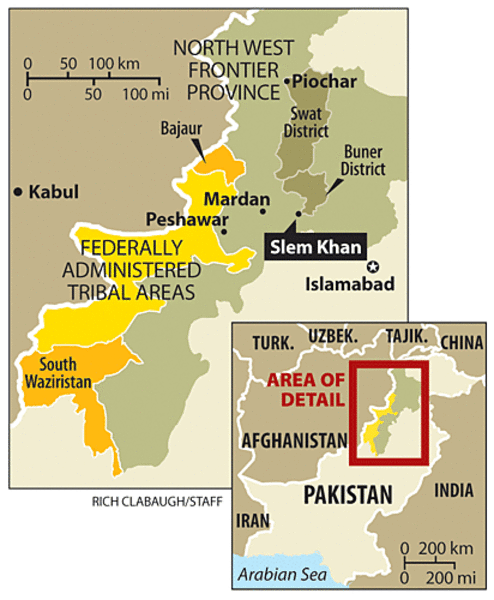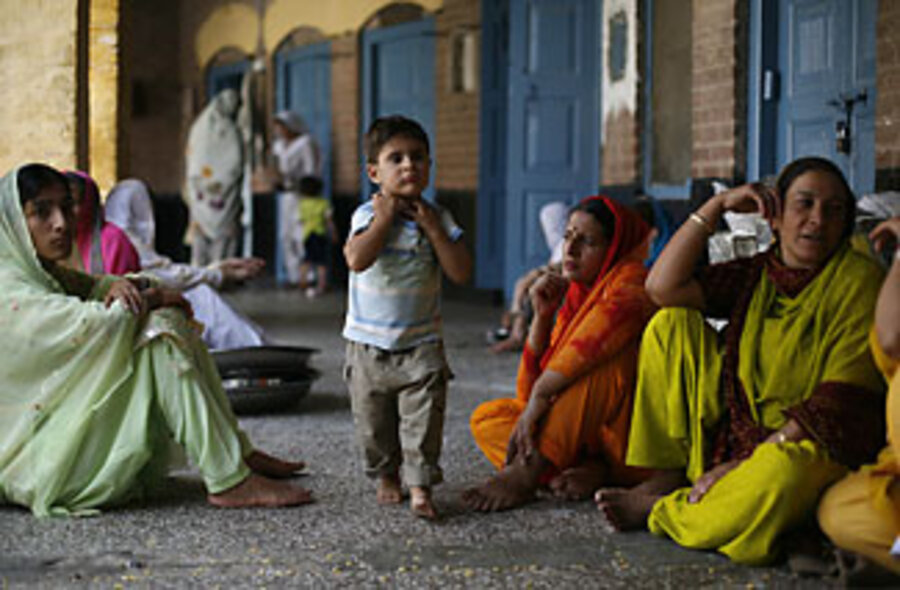Pakistan can clear Taliban territory, but can it hold it?
Loading...
| Slem Khan, Pakistan
Worried about his crops and property, and hearing that the curfew had been lifted, Shamsul Qamar and his son paid $5 for a ride back home to Pakistan's Buner district this morning. When they arrived they heard explosions as government aircraft fired on the Taliban, who are fighting to maintain control of the area. Pakistani security forces promptly told them to turn around.
Now he's back where he started at a crossroads three miles outside Buner, watching families piled on trucks make the same hopeful journey home.
"Those families who are going back, they will return again," says Mr. Qamar. "I will go back only when there is complete peace, when the security forces have complete control, and when there is law and order with a local administration and police."
That's a tall order, but that's precisely the task facing the government if it hopes to not just finish this battle with the Taliban, but win the peace. Pakistan is trying to wrest control of Buner from the Taliban, who seized the district – just 60 miles from the capital, Islamabad – last month. But the military Pakistan has a poor track record of holding cleared territory, leaving many experts and refugees skeptical about the long-term gains from this operation.
"The Army can clear if by clearing it means utter devastation, but it certainly doesn't seem able to hold," says Christine Fair, an analyst with RAND Corporation in Washington. "Partly they have a doctrinal problem. They don't have a lot of institutions you'd expect them to have, because they are not a counterinsurgency military."
To assist Pakistan in this effort, Secretary of State Hillary Rodham Clinton announced Tuesday that the US would provide $100 million in humanitarian aid and that the US Defense Department would give another $10 million in unspecified assistance.
“Providing this assistance is not only the right thing to do but we believe it is essential to global security and the security of the United States and we are prepared to do more as the situation demands,” Ms. Clinton told
reporters at the White House.
A bridge between civilians and the military
Pakistan does have some institutions valuable for this transition, however. One is the district coordination officer, or DCO, who acts as a bridge between military and civilian administration in a given region. It's a role that gained more power under the former military dictatorship of President Pervez Musharraf.
The DCO for Buner, Yahya Akhunzada, says he has been meeting nearly every day with the military to coordinate the return of people, police, and administration to cleared areas. Police are starting to return to Daggar and Totalai, two regions in lower Buner. Within a week, 200 police will be sent from the provincial capital of Peshawar as reinforcements, allowing routine policing to restart in these areas.
It's not a job for the faint-hearted.
"The morale of the police is low," says Mr. Akhunzada. When Taliban come to an area, they target the police first. That makes his police fearful to return in case "something wrong happens and the militants are not damaged a lot."
And until the police have regained their footing, it's unlikely judges will return to their courts, teachers to their classrooms, and residents such as Qamar to their homes.
Backstopping the police is where a good paramilitary force ought to step in to relieve the Army – and where Pakistan admits it has a problem.
"The capacity of this Frontier Constabulary needs to be enhanced and the Army would [likely] find itself in the policing roll for a long time in these areas in order to enhance the capacity of the police," says Army spokesman Gen. Athar Abbas.
1.5 million people displaced
That's a problem, says Ms. Fair, because armies do not make good police forces, and this particular Army "has some bridges to mend" with the refugees it displaced. The United Nations said Monday that some 1.5 million Pakistanis fled from the military counteroffensive – an exodus unseen in speed and scope since Rwanda's 1994 genocide.
Many of those forced to flee say they want neither the Taliban nor the military in their homeland. "When the Taliban and the Army move out, then we will move back," says Bakht Zaman, a Buner refugee in the overflowing Sheikh Shehzad camp in Mardan. "We don't want to spend the summer in the camps."
Nine days ago, the Sheikh Shehzad camp still had empty fields for more tents, and the occupants drew on reserves of patience. Six days ago, the camp ran out of space and offials barred the gates to new families – sending them down the road to a camp that's also now full. Unwelcome guests keep coming, however, including a scorching heat wave and a politician who yesterday unveiled a water pump that promptly failed.
The camp now has 163 latrines. A UNICEF official at Sheikh Shehzad noted that camps should have one latrine per 20 people – the ratio is 50 to 1 here and residents are defecating in washrooms.
Army has broad support ... for now
While some internally displaced persons (IDPs) are angry with the Army, the operation generally appears to have broad support across Pakistan. But that support could erode quickly, the longer the IDPs suffer in the camps.
The troops are hitting the Taliban leadership in Swat, "and by doing so they are getting a lot more support of the people than they did in the past – provided the IDPs are taken care of," says Gen. (ret.) Talat Masood. "This is the crux of the whole thing."
The ticking clock of public support puts more pressure on the military to focus on wiping out the insurgent strongholds. But having to police areas will sap the manpower of the 18,000-strong force, which is just a few thousand soldiers more than the military deployment in Swat Valley before the failed peace deal in February.
General Abbas estimates it will take another eight to 10 weeks to clear the main road and destroy the militant headquarters in Piochar, a remote town on the edge of Swat. Eradicating the militants from the surrounding hills will take longer. As will holding the territory: "For that, we see a long and drawn-out time," says Abbas.
It's not clear that top civilian authorities are preparing the population to think along these time frames. On Sunday, President Asif Ali Zardari said the military was headed to South Waziristan next.
Abbas downplayed the idea: "If the situation arises there and if the government orders, then of course the military would deploy there, but there are two ifs in that."
A second front in South Waziristan?
However, the Taliban leader in South Waziristan, Baitullah Mehsud, is threatening to open up this second front. Last week, his men distributed a pamphlet promising war by May 25 if drone attacks are not stopped, prisoners released, and the Army withdrawn from areas of South Waziristan. Locals reached by phone report that five families a day are fleeing the lands between the security forces and the militants, and both sides appear to be ramping up for a fight.
A simmering situation also remains in the tribal area of Bajaur – an area the Army said it had almost entirely cleared nearly three months ago. Refugees and residents reached by phone report that fighting continues and the Taliban have targeted tribal elders despite a peace agreement. In a possible foreshadowing of the difficulties ahead in Buner and Swat, less than half of the 550,000 Bajauris who fled the clearing operation have returned.






